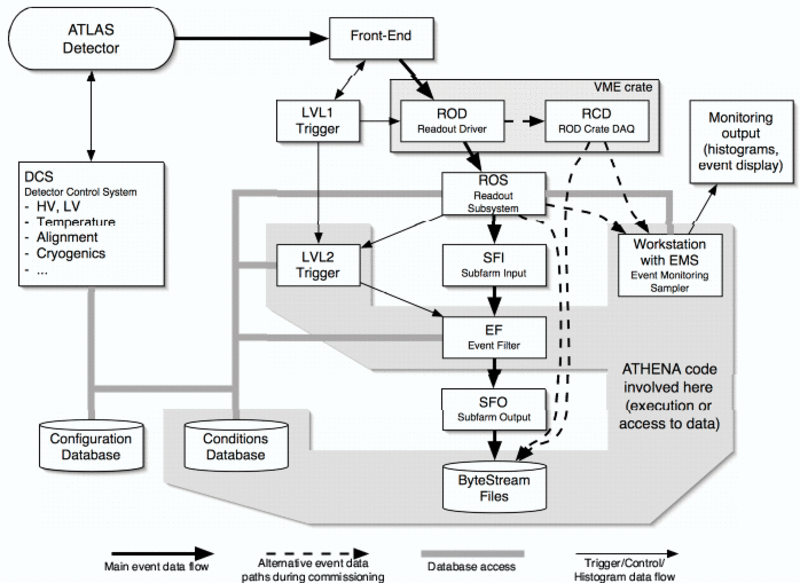   |  |
Computing Technical Design Report
Commissioning the ATLAS detector will be a major focus of the Collaboration for the next few years. The use of offline tools, including the offline software, computing and databases, can both facilitate the detector commissioning and ensure that the offline is itself ready for ATLAS data analysis from the earliest collisions.
The approximate time-scales of detector commissioning activities are outlined in Table 3-1.
|
Byte-stream converters, |
|||
A critical first element for the use of the offline software for detector commissioning is the access of data in Athena, both event data and conditions data. Detector data flow paths are sketched in Figure 3-14.

|
Athena can access event data online on the High-Level Trigger processors, be run on raw (byte-stream) data files, or run on any system accessing events via the TDAQ "event sampler".
Initial ATLAS "phase 1" commissioning activities will proceed within each subsystem independently. At this stage detectors will be installing front-end electronics, and taking local pulser or calibration triggers to verify successful installation. The data, primarily written using the VME readout and the ROD crate DAQ (RCD) system, will be written in standard ATLAS byte-stream files that can be analysed from Athena or other software. At this stage, it is critical that the system byte-stream converters are able to decode the detector fragments from the byte-stream, and that the software environment be flexible enough to keep pace with potentially rapid changes in the detailed event format as the first data is recorded. The first use of these data will be to verify the functionality of the front-end and readout electronics. Relatively little reconstruction will be required initially, but a detailed data-monitoring, event-display and histogramming environment will be important. The monitoring tools and "AthenaMonitoring" environment developed for the 2004 combined test-beam tests (CTB) can potentially be extended for use for detector phase-1 commissioning activities. It is also important that detector byte-stream converters and monitoring tools be archived and maintained in the central ATLAS CVS repository, ensuring their availability for future use.
Event-data files will already require file management and archiving from the early commissioning phases. These files will typically be written from an online workstation to a local disk, and will be analysed both locally and remotely. Aggressive migration towards prototypes of the ATLAS data-management system from the early commissioning stages will ease file access with the offline software and also provide file and run book-keeping tools.
The initial data runs will produce calibration data, which in some cases can be used for the production of calibration constants written to the conditions DB. This requires the extension of detector-calibration software to the full set of channels present in ATLAS, and also the use of final ATLAS conditions DB tools such as the LCG COOL conditions database and POOL file persistency.
In addition to event-data access via files, the offline software can also be run on the high-level trigger or other online workstations. Any online machine on the ATLAS control room network (ATCN) can access event fragments via the TDAQ online "EventMonitoringSampler" (EMS). The EMS was used successfully for certain monitoring applications in the 2004 test beam, although not using Athena-based monitoring applications. Recent developments have made it possible to access data via the EMS from Athena, as illustrated in Figure 3-13. Via the EMS, it is possible to analyse data using the same offline tools from any stage of the TDAQ readout chain. These monitoring tools can be used from the earliest commissioning phases.
After (and even during) phase-1 commissioning, the different subsystems will be integrated together into combined events, called commissioning phase-2. At this stage, it is obviously critical that all system byte-stream converters and monitoring tools run in a common software release, and the maintenance of this commissioning release will be important. It is also important that all systems are using common database tools by this stage. Dedicated updates of the ATLAS releases and use of CVS during phase 1 will make this transition smoother.
Commissioning phase-3 starts with cosmic-ray muon runs, and continues with single-beam running where beam-halo muon and beam-gas events can be collected. The rates of these events have been studied [3-39], and appear to be very useful for detector commissioning and early calibrations. These events are useful for channel-timing adjustment, detector alignment, and energy calibration. First cosmic-ray data taking will start in the autumn of 2005 with sector 13 muon-chamber cosmic runs in the ATLAS pit and SCT+TRT barrel runs on the surface. The tile calorimeter barrel will be fully instrumented and able to participate in common cosmic runs with the muon system in late 2005, and the liquid argon barrel calorimeter will be able to join in early 2006. The endcap calorimeters, inner detector barrel and endcaps, and the pixel system will be installed and ready throughout 2006 and early 2007, and a full combined ATLAS cosmic run will be possible in spring 2007. Single-beam running is scheduled to take place by the summer of 2007.
The reconstruction of cosmic-ray, and later beam-halo, muon events requires special tools in the offline software. These events do not arrive synchronously with the LHC (25 ns) clock, and are not pointing to the detector origin. They are, in some aspects, more analogous with test-beam data than LHC collision data. Tools will be required to reconstruct the event time for use in system reconstruction; tracking software must not require pointing tracks and must accommodate the different "sign" of energy loss, and calorimeter reconstruction must cope with the asynchronous events. While significant work has been done in these areas using either the commissioning MC samples described in See M. Boonekamp et al., Cosmic Ray, Beam-Halo and Beam-Gas Rate Studies for ATLAS Commissioning, ATLAS Internal Note, ATLAS-GEN-2004-001 (2004) or using test-beam data, more effort is required to allow the full utilization of the commissioning samples.
   |  |
Copyright © CERN 2005